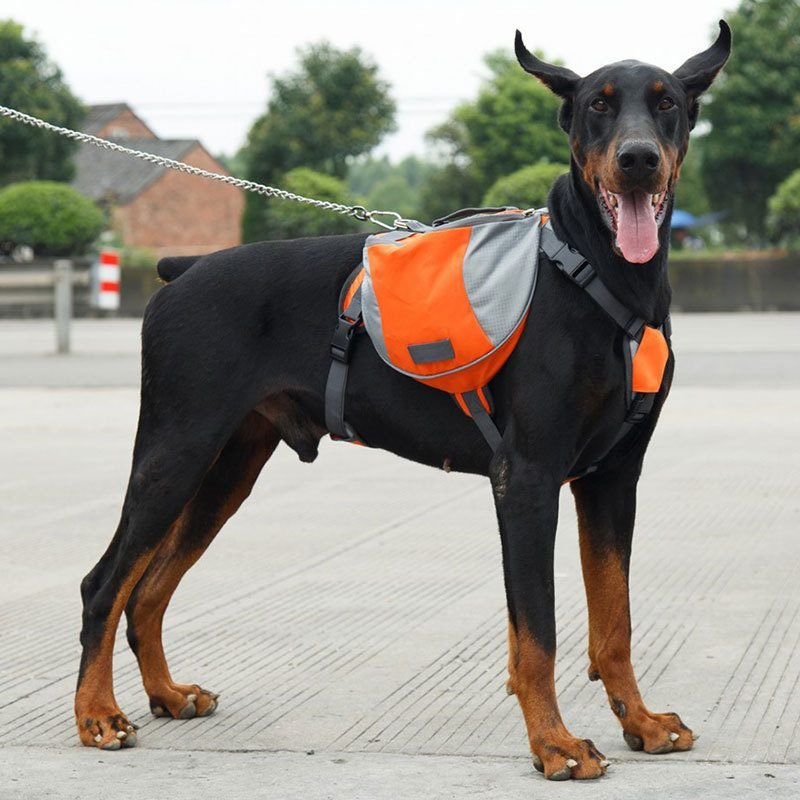When embarking on a hiking adventure, having your dog carry their own supplies can be a tremendous relief. Not only does it lighten your load, but it also gives your dog a sense of purpose and responsibility. However, it’s crucial to determine the appropriate weight your dog can carry to ensure their safety and well-being. By understanding the factors that influence a dog’s carrying capacity, such as breed, size, fitness level, and overall health, you can optimize their hiking experience. In this comprehensive guide, we will explore how to determine the ideal weight for your dog to carry.

- Understanding Your Dog’s Physical Capabilities
1.1 Breed Considerations:
- Large Breeds: Examples include Labrador Retrievers, German Shepherds, and Bernese Mountain Dogs. They can typically handle loads ranging from 20% to 25% of their body weight.
- Medium Breeds: Examples include Border Collies, Australian Shepherds, and Siberian Huskies. They can generally carry loads ranging from 15% to 20% of their body weight.
- Small Breeds: Examples include Jack Russell Terriers, Chihuahuas, and Shih Tzus. They have more limited carrying capacity, typically up to 10% to 15% of their body weight.
- 1.2 Size and Weight:
- Large Dogs: Dogs weighing over 70 pounds can often carry loads ranging from 15% to 25% of their body weight.
- Medium Dogs: Dogs weighing between 30 and 70 pounds can typically carry loads ranging from 12% to 20% of their body weight.
- Small Dogs: Dogs weighing under 30 pounds have more limited carrying capacity, generally up to 10% to 15% of their body weight.
- 1.3 Fitness Level:
- Well-Conditioned Dogs: Dogs that engage in regular exercise and are physically fit can handle heavier loads compared to less active dogs. Their endurance and strength allow them to carry loads closer to the upper range of their capacity.
- 2: Considering Health and Age Factors
- 2.1 Health Evaluation:
- Consult with a veterinarian: Before assigning any weight-carrying duties to your dog, it is essential to consult with a veterinarian to ensure they are in good health and capable of handling the physical demands.
- Health conditions: Dogs with pre-existing health conditions, joint problems, or injuries may have limitations on the weight they can carry.
- 2.2 Age Considerations:
- Puppies: Puppies are still developing, and their joints and bones are more vulnerable. They should not carry any weight until they have reached skeletal maturity, usually around 12 to 18 months.
- Senior Dogs: Senior dogs may have reduced stamina and mobility. It’s important to consider their overall health and energy levels when determining the weight they can carry.
- 3: Determining the Appropriate Load
- 3.1 Percentage of Body Weight:
- General guideline: Dogs should generally carry no more than 15% to 25% of their body weight. This range allows for a balance between challenging your dog and avoiding excessive strain.
- Example: If your dog weighs 60 pounds, their load should ideally be between 9 and 15 pounds.
- 3.2 Gradual Conditioning:
- Start light: Begin with lighter loads and gradually increase the weight over time to allow your dog’s muscles, joints, and stamina to adapt gradually.
- Example: Start with a load of 5% to 10% of your dog’s body weight and gradually increase by 5% every few weeks.
- 3.3 Distributing Weight:
- Use a well-fitted backpack or harness designed specifically for dogs to ensure even weight distribution.
- Example: Distribute the load evenly on both sides of the backpack or harness to avoid strain or discomfort.
- 4: Monitoring Your Dog During the Hike
- 4.1 Signs of Discomfort or Fatigue:
- Observe your dog for any signs of discomfort, such as limping, excessive panting, or reluctance to move. These signs may indicate that the load is too heavy or that your dog needs a break.
- 4.2 Regular Breaks and Hydration:
- Provide your dog with frequent breaks and access to fresh water to prevent dehydration and fatigue. Resting allows your dog to recover and regain energy during longer hikes.
- 4.3 Adjusting the Load:
- Continuously assess your dog’s comfort level throughout the hike and be prepared to adjust or redistribute the load if necessary.
Conclusion:
Determining the appropriate weight for your dog to carry during a hiking adventure is crucial for their well-being and enjoyment. By considering all the factors above, you can ensure that the load is within your dog’s capabilities. Regular monitoring, gradual conditioning, and responsible weight distribution are key to a safe and comfortable hiking experience for your furry companion. Remember, the primary goal is to enhance your dog’s enjoyment of the hike while prioritizing their health and safety.
(Note: This guide provides general guidelines and information; however, it is important to consult with a veterinarian for personalized advice regarding your specific dog’s capabilities and health conditions.)
